 | 330 GT Registry |  |
MODERN MOTOR — July 1966
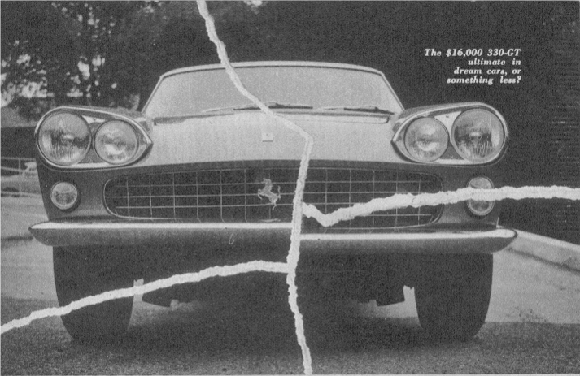
TEARING UP THE BIG FERRARI MYTH
Forget the propaganda — what would happen if Enzo’s famous noise machines were judged on the same basis as other cars? You might be in for a shock when you read this explosive report printed by special arrangement with U.S. “Road Test” magazine.
The prancing horse of Maranello is one of the most honoured emblems in motoring. As the trade-mark of Enzo Ferrari, it is viewed with reverent awe throughout the world. By the racing enthusiast as the badge of grand prix success, by the sports-car fan, as the symbol of ultimate in performance and road- ability, by the moneyed man about town, as the supreme status symbol, the sign of one of the world’s most expensive and most exclusive cars.
But, to the editors of Road Test, it represents too much prance and not enough horse.
Ferrari, like Rolls-Royce, is an incredibly overrated auto-maker. His cars enjoy world-wide prestige be cause of an exaggerated reputation and excellent promotion, not because of reality.
The reputation is based on Ferrari’s undeniable success in racing. And the promotion has managed to transfer the glamour and mystery of the fiery red single seaters to the ordinary passenger cars, to transform the latter into supposed embodiments of automotive ‘virility.
This rub-off was accomplished, not by merely using the same nameplate and type of engine—as has been the historical practice—but by brazenly employing the unrefined and totally unsuitable early race car design in so-called luxury touring cars.
Ferrari is said to be a genius like Ettore Bugatti, who has created a series of mechanical masterpieces. From his first 1.5-litre Type 125 back in 1947 to his latest 5-litre “Superfast,” his cars have been regarded as the finest and fastest of their kind. And, invariably, the man whose name they bear has been ‘iven credit for their concept and design.
Genius he may be. But, if so, it is in the field of myth-making, not engineering.
Ferrari himself, unlike Bugatti has had little to do with the design of his cars. They have been created by subordinates. The credit — or blame — for the vehicles belongs to these hired hands, not to the aloof Commendatore in the front office.
To him does go credit for making a fortune out of a fable. And blame for perpetrating the fable in the first place.
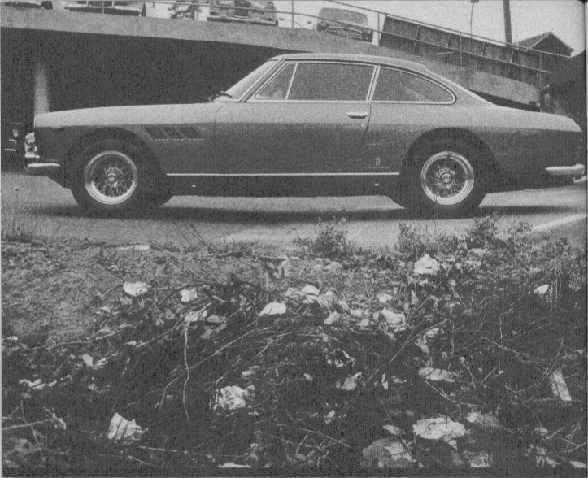
The key to the Ferrari legend is a 60-degree V-12 engine, originally conceived and developed nearly twenty years ago by an engineer named Gioacchino Colombo.
Ferrari chassis design has never really amounted to much. Even the marque’s racing success can be attributed to engine performance, not to chassis engineering.
The low, red cars have scored in competition despite their steering, suspension, and braking, not because of them.
Ferrari builds only engine and chassis components. Bodywork is farmed out and the Maranello factory becomes involved in it only to the extent of approving suggested styling ideas from coachbuilders.
Nonetheless, Ferrari must accept the responsibility for the complete vehicles that carry his prancing horse badge. It’s his fault — not, say, Pininfarina’s — that the cars reach their buyers in such shabby condition. The coachbuilders are capable of better workmanship when it’s required.
Right from the start of his car-making career, Ferrari has shown no real concern for proper construction and we find it astonishing that no body has called him on it long before, this. His first vehicles, the grand prix cars he fielded right after World War II, were very badly built and failed to meet minimum standards in finish or driver comfort even for racing bodywork.
The same thing proved regrettably true when he began offering cars to the public. The coupe and convertibles he sold to a wealthy but unwary clientele were poorly assembled, uncomfortable and extremely difficult to drive.
But they were Ferrari. and nobody dared question that they might be something less than the absolute pinnacle in automotive engineering and construction.
Their level of finish would shame oven the lowliest California customiser. The aluminium bodywork was made of one-foot square sections of sheet metal, formed over bean bags and then welded together in a quilted approximation of the original design sketches.
At a distance, these cars were beautiful, but when you got up close you could tell they were Italian. They had hair under the fenders.
The interiors were austere to an extreme, though one might consider them an appropriate final touch for what proved to be a sort of auto motive sackcloth and ashes.
Ferrari had given Europe’s wealthy and titled nobility something these elevated classes hadn’t seen since the Middle Ages. An elaborate and ostentatious way to do penance in public.
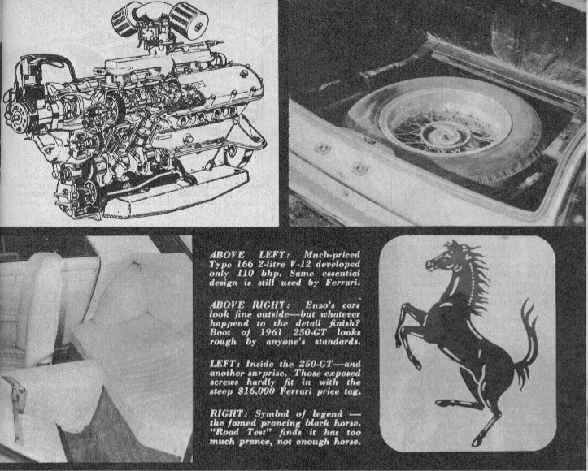
That V-12
The rather sketchy upholstery in these early “sporting” Ferraris came unglued—literally—when it was exposed to the rivulets of water that seeped through a poorly sealed wind shield and ill-fitting doors.
The windshield, incidentally, was the only sizable piece of glass in the car. The rest of the windows were plexiglass and invariably scratched and crazed to such a degree that any attempt by the driver to see what was behind or beside him became something of an adventure.
As for riding comfort, it was virtually non-existent. Thin seat pad ding was combined with extremely stiff springing to make a trip over anything but the smoothest pavement a kidney-shattering experience.
Some of these deficiencies are bound to occur in a so-called sports car. But one expects them to be balanced by superior driving qualities. In a Ferrari, though, even that particular compensation is limited.
The cars generally are abominable in traffic and indeed thoroughly frustrating anywhere but on the open road.
The difficulty here is an engine with poor low-end response, together with a severely positive clutch.
In most of its manifestations, the Ferrari V-12 has hit its torque peak around 5000 rpm and its highest horsepower reading at 7000 rpm.
As cases in point, the familiar 3-litre 250-GT powerplant, the unit found in the original “two-plus-two,” delivered 181 ft./lb. of torque at 5000 rpm and 240 bhp at 7000, while the 4.9-litre version produced 311 ft.! lb. and 360 bhp at those same crank shaft speeds.
Now, an engine which has to be revved that fast for maximum efficiency isn’t going to be very responsive at normal operating speeds. It’ll bog and sputter in traffic, for example, protesting that it is a thoroughbred, not a draughthorse.
Add to it an extremely sensitive clutch, one with very little allowance for slippage, and you have real problems.
To move a Ferrari smartly off the line calls for skilled technique. If the pedals aren’t manipulated with care, the engine will stall or the clutch will be subjected to severe wear and will require frequent attention and adjustment.
A glance at the various kinds of clutches that Ferrari and his under lings have tried to snap to the V-12 engine shows that the crew at Maranello is aware of this flaw but has had considerable difficulty trying to cure it.
Early road versions of the marque had a fierce, multiple-disc unit that was either in or out. It couldn’t be slipped at all. A standard, single-disc design was next, but required constant adjustment for proper operation.
Then, a double-disc type was tried. However, it was too thick and heavy and it wore much too rapidly. Currently, a single-disc, centrifugal unit is fitted.
In short, Ferrari has had a bear of a time finding a clutch that will make the high-revving V-12 tractable in everyday street operation.
But get a Ferrari off city streets, get it out on the highway, and all this becomes academic. At high cruising speeds, that 12-cylinder engine comes into its own. It delivers a smooth, turbine-like flow of power quite unlike any other car in the world.
Still, it must be judged in terms of performance , not here, again, we find the Ferrari reputation overinflated.
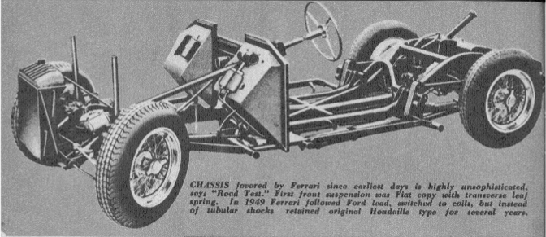
Comparisons
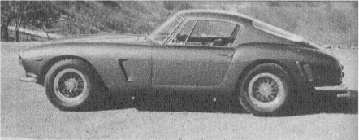 This is the 250-GT Berlinetta—one of the most glamorous Ferraris ever. But has it been overrated in terms of performance and construction? |
Take the production, steel-bodied 250-GT which was introduced a few years a the one that still spells “Ferrari’ for most fans.
In “two-plus-two” form, it was capable of blasting from zero to 60 mph in 8sec. flat and from zero to 1110 in 22.8sec.
Let’s compare that with another vintage, not a super stock built for drag racing but a tractable, everyday sports car, the Shelby-American Cobra.
In its original 260 Cu. in. form this little Ford-powered two-seater could run from a dead stop to 60 mph in only 4.2sec. and to 100 mph in 10.8! And that, mind you, was the mildest Cobra ever built!
Sure, there are some inequities. The Ferrari 250-CIT displaced only three litres while the early Cobra had 4.2, and the “two-plus-two” weighed l000lb. more than the Shelby product.
But Ferrari boasts of absolute performance, without taking such factors into account. And the car must be evaluated on that basis, not excused because its engine is too little or its bodywork too heavy.
Besides, the inequities also work the other way. The “two-plus-two” cost $U.S.1l,000 and the Cobra $U.S.6000, hardly half as much. It doesn’t take any calculating at all to see which was the better buy for the out-and-out performance enthusiast.
If we move up to the big-inch Ferrari, the 4.9-litre, we still won’t find quite the explosive performance we’ve been led to expect. The 4.9 has a zero-to-60 time of 6.6sec. and a zero-to-100 of 14.5, brisk figures indeed. But an equipped Pontiac GTO can hit 60 mph in 4.6sec. and 100 in 11.8!
This time we’ll hear no complaints about relative engine sizes and vehicle weights. While the GTO has a 1.6 litre advantage over the output is actually less.
The big Ferrari delivers 360 bhp and the Pontiac 348 bhp. And weight figures are identical. Both the 4.9 and the GTO tip the scales at 3850lb.
So the big Ferrari has a better power-to-weight ratio than the little Pontiac—yet it takes longer to reach 60 mph!
As for price, Ferrari wants $U.S.23,000 for a new 4.9 while Pontiac will let you have a well equipped GTO for roughly $U.S.4000. No comment is needed on that difference!
DOUBLE-DISC clutch (left) used in some Ferraris, required frequent painstaking adjustments. RIGHT: Cam timing changes as you driver because of long chain's stretch and single tensioner. Loose chain means trouble.
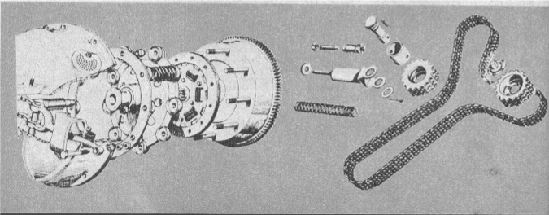
Beyond its discomforts and its indifferent performance, the Ferrari has certain inherent design weaknesses that still haven’t been overcome after nearly two decades of manufacture.
The clutch is one, as we’ve seen. The differential is another.
The older Ferrari differential used a split-ring radial thrust bearing to locate the pinion shaft. The assembly was shimmed in such a way that a mechanic — even a highly skilled one — could easily fail to align the gears in a proper mesh.
The factory finally recognised this problem but, on newer models, has come up with an absolutely incomprehensible solution. There are now three bearings on the shaft.
Anybody with any appreciation of engineering principles can only view this device with bewilderment. When three bearings are placed on a single shaft, only two of them are going to accomplish anything. The third will merely be along for the ride.
The result is a differential that works in some cases but not in others, depending on which two of the three bearings seat in properly.
Difficulties of this sort would be more tolerable if there were competent Ferrari mechanics who knew how to take care of the car. Unfortunately, there aren’t.
Men who really understand the idiosyncrasies of the marque are next to impossible to find this side of Italy or, at best, Switzerland. And those aren’t exactly convenient places to drop off the car for servicing on the way to work.
The Ferrari owner who does find a mechanic he can trust still faces an impossible parts situation. Even the most fundamental components will take weeks for delivery from the factory.
And the simplest screw will pass through a long chain of hands that have to be greased with silver; by the time the item reaches the customer, its price will have been inflated completely beyond reason.
Cost of repairs
The biggest service and repair headache of all is that highly touted V- 12 engine. It is a brilliantly smooth powerplant when in first-class shape.
But keeping it that way involves far more than an occasional tune-up. It calls for a great deal of trouble— and expense.
A mechanic who knows anything about Ferrari engines will charge at least $U.S.750 to go through it.
That’s not counting the cost of removing the unit from the car. Nor does it include the price of any re placement parts. It’s merely the starting figure f the mechanic’s labor.
At that, he won’t make an easy t buck. The Ferrari powerplant is something to work on. As one ex ample, he’ll have to time and synchronise the separate camshafts on both cylinder banks.
The/long timing chain that operates both cams tends to stretch and to bow quite rapidly. It has only one adjustment, an idler sprocket on the right side.
As slack in the chain is taken up, the relationship between the cams is altered and overall valve timing thrown out of whack. It takes a lot of jiggling to get both cams just right.
But the biggest problem is the block. Because of its 12-cylinder configuration, it’s quite long in relation to its height. As a result, it’s unusually flexible.
Extreme care is necessary to maintain the alignment of the main bearing bores. The nuts on the caps must be torqued with absolute accuracy to avoid even the slightest distortion. In fact, it’s even possible to upset the alignment of the bores by torquing the head bolts too strongly.
Even the legendary V-12 engine, then, has some extremely serious shortcomings. Add these difficulties to the car’s many other deficiencies and it’s hard to grant the Ferrari any saving graces at all.
Faint praise
How is it possible that such a car commands such universal respect? How did such a poorly designed and badly built machine get a reputation for outstanding quality?
We can only blame the writers and road testers for the enthusiasts’ publications who, apparently dazzled by the success of Ferrari’s racing vehicles, are blind to the shabbiness of the passenger cars.
They do recognise many of the car’s individual faults, but they fail to add them up and find the overall sum, the utter and complete mediocrity of the car.
They praise with faint damning. They see every flaw as an exception, yet don’t seem to comprehend that in a Ferrari these exceptions are the rule.
However, if one casts a careful eye on the reports these men prepare, the truth begins to emerge. Amidst the generalities of praise one will find the specifics of condemnation. And, collectively, these bits of criticism form a most unflattering portrait of the Ferrari — unflattering but all too true.
One recent road test of a Ferrari in a major automotive magazine is typical. Poking through an awkward package’ of praise are such barbs as these:
“Things like steering effort and pedal pressure have traditionally been high, sometimes requiring great strength and always demanding good co-ordination, but these are similar to the driver demands made by light delivery trucks.”
Consider these com in the same report about the rear-mounted transmission of the latest Ferrari:
“(The gearing) is still all indirect, which means that, even in top gear, a pair of cogs are working. which accounts for the fact that it is uniformly noisy no matter what gear it’s in.
‘The gears are damned noisy and a long trip with the top up might find their racket intrusive and tire some.”
The test goes on “to offer these remarks about driver comfort:
“But the driver’s foot well is all filled with pedals and things, so that he must sit with his knees splayed apart in a fairly uncomfortable position . . . The window cranks are located way down in the lower front corners of the doors.
“For the passenger, this only means an inconvenient bend forward, but for the driver it means feeding his hand through the narrow space between the arm rest and the steering wheel rim—a space already filled with his knee, which can’t be moved.
“For safety’s sake, about the only way the driver’s window should be raised or lowered is to stop the car and open the door.”
And, as a final quote from that particular essay, here’s a dazzling attempt to avoid the real issue:
“Heavy traffic can still start the water-temperature needle moving up past the 200 mark in warm weather, but it’s a lot better than its predecessors.” In other words, the thing overheats!
Flipping to an older issue of an other enthusiasts’ magazine, we find these notes buried in an otherwise glowing account of the “two-plus- two”:
“The major (faults) are clutch slippage and overdrive problems... Every Ferrari we’ve tested (and every Maserati,. too) has had an extremely inaccurate speedometer; some running to 15 percent off and always on the high side.”
This same publication also had some trenchant observations about the incredibly expensive 4.9.
“During the acceleration tests we experienced considerable clutch slip page, but little wheelspin . . .. Because of the torque and power avail able, and car’s weight, it is absolutely necessary that the gears be completely engaged and the clutch fully out before much throttle is applied to prevent damage to the drive train.
“The car is a paradox in that it is a handful to drive but should not be manhandled . . . The steering is heavy by Ferrari standards . . . The weight balance and chassis design of the 4.9 produce a definite understeer.”
Other comments
Here are some random remarks from various publications that have made a career of acting as Enzo Ferrari’s publicists:
• “The combination of thrashing machine sounds up front and droning exhaust out back . ..”
• “But one tends to be a bit surprised by the sort of deliberate ponderous nature of its going. It is not by any stretch of the imagination light or quick.”
• “The chassis is not particularly exciting. It’s big, strong, and unimaginative in the Ferrari tradition.”
• “Switches are unmarked or, worse, marked with symbols so obscure as to take your mind off driving while trying to decipher them.”
• “Legroom is insufficient.”
• “The car cannot conceivably be driven Moss-style with arms out stretched, unless one has very little bitty arms indeed.”
• “The ride is best described as harsh and choppy.”
• “We found that, without conscious effort, we maintained better averages over the same back roads in a Mercedes-Benz 220-SE coupe.”
And on and on and on.
Here the Ferrari stands exposed and indicted in the words of the men most responsible for furthering the legend of the car’s greatness. But we doubt if they’ll own up to reality because they appear to be totally un aware of it. They continue to sing the praises of the prancing horse even while they cast an occasional furtive glance at its feet of clay.
And the black stallion will continue to dance on the yellow shield. But a few will realise that the melody to which it dances is cheap and tawdry, only an echo of what it pretends to be.
MODERN MOTOR — July 1966